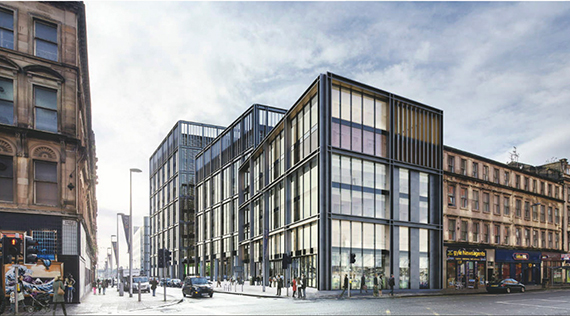 HMRC’s requirement for new offices in central Glasgow is taxing a market that has seen no speculative building for more than three years. Mark Simmons reports
HMRC’s requirement for new offices in central Glasgow is taxing a market that has seen no speculative building for more than three years. Mark Simmons reports
Something odd is going down in Glasgow. At the same time as the city has one of the largest office requirements in living memory it is also experiencing one of the longest pauses in significant speculative office development that anyone can remember. So what’s going on?
Let’s take the mammoth requirement first. The Government Property Unit, as part of a nationwide occupational consolidation process, is looking for up to 650,000 sq ft in Glasgow. To see why that is such a big deal, consider the average annual take-up figure over the past decade: around 550,000 sq ft. Although the GPU doesn’t want all the space at once, it is aiming to move reasonably quickly. The first phase of the requirement, between 215,000 and 280,000 sq ft for HMRC, suggests the first tax people, who will be moving from existing city centre offices as well as in satellite locations including Cumbernauld and East Kilbride, may want to be at their new desks in 2019.
For that to happen the GPU will need to get its skates on. Already in the last few months an initial shortlist of seven sites has been whittled down to a final three (see panel). Market commentators say that GPU stipulates that its chosen site must be within a 10-minute walk of both of the city’s main railway stations – Central and Queen Street – which rules out any far-flung locations.
A decision could be made before the end of this year, though local property people don’t expect a formal announcement until early 2017. And once the HMRC location is settled, attention will rapidly shift to GPU’s further requirement for more than 300,000 sq ft.
In normal circumstances the Glasgow property market might be expected to be cock-a-hoop with such mega-requirements. But these are not normal times, with a hiatus in supply. “Glasgow has a rapidly reducing supply of large, top-quality big floorplate accommodation due to no new speculative office development being undertaken for three years, a first in my career,” says Phil Reid, veteran Glasgow office agent and vice-chair of the British Council for Offices’ Scottish Chapter.
Audrey Dobson, senior director at CBRE, agrees: “It’s not really a situation Glasgow has been in before. However, we also have requirements [excluding GPU] totalling 500,000 sq ft. If I had the money I’d be looking at that!”
And cash is what it appears to be coming down to. Andy Cunningham, head of office agency at Cushman & Wakefield, says: “No-one has got money to build – so developers are just sitting tight. The only construction taking place speculatively is refurbishments.” (See below).
Although foreign investors, who are completely unfazed by political factors such as Scottish independence (see politics feature, pxx), have shown an increasing appetite for Scottish property, they are unlikely to be attracted to Glasgow’s current offer of pipeline city centre schemes. Cunningham explains: “Chinese and similar investors like to see big consolidated schemes – they’re looking for 1m sq ft minimum. Single building schemes simply aren’t big enough.”
So although Glasgow agents look hopefully at Titan Investors pushing the button on its 95,000 sq ft New Exchange scheme some time in 2017 (it was originally tipped by the market to start in Q1 this year), they acknowledge that they may have longer to wait. David Cobban, director of business space agency at Savills concludes: “For the next period there will be a hiatus in speculative development – at least for a couple of years.”
No big change for office rates
With existing Glasgow occupiers facing the prospect of little new-build or big-floorplate refurbished floorspace coming on stream in the short term they may well opt to stay put. But are they still at risk of being bush-whacked by next year’s rating revaluation? CBRE’s head of Scottish rating Brian Rogan thinks not. “The values underwent a huge change last time [in 2010], so I don’t expect major changes this time round,” he says. Although full details of the revaluation in Scotland have yet to be revealed by the Scottish government (see rating feature) the main area of uncertainty is for tenants who occupy different floors in the same building. Previously, all floors were effectively taxed as one but, since the Woolway v Mazars court case last year, assessors will now treat each floor individually.
Whether this means higher or lower bills for Glasgow office occupiers is unlikely to become clear until early next year.
Glasgow’s Brexit Demands
For David Melhuish, director of the Scottish Property Federation, the hiatus in speculative office development in Glasgow highlights the need for the Scottish government to kick-start the economy.
He says: “The government has got to make it an attractive place to come [and do business]. If it’s not happening there needs to be an incentive for people to take that risk if we want the economy to grow.”
Melhuish isn’t alone. Last month Glasgow City Council and two other Glasgow organisations published a report calling for UK and Scottish politicians to implement policies that will expand the city’s economy. One of six core Brexit ‘asks’ is a two-year moratorium on business rates for new-build grade-A properties that are not fully let.
Like many property professionals the report’s authors believe this would stimulate speculative development at a time when it is most required post-Brexit.
Anne Murray, inward investment manager at Invest Glasgow, agrees. She says: “Developers see plenty of opportunities in Glasgow that aren’t in places like Manchester and Birmingham.”
More refurbs in the pipeline
With no sign of a speculative start on a new office development (see above), refurbishment schemes could become more popular. So far refurbishment has tended to be modest, of buildings with floorplates under 10,000 sq ft.
Refurbished buildings with big floors are really scarce,” notes Cushman & Wakefield partner Andy Cunningham. That may be about to change: Moorfield plans to revamp Buildings 1, 2 and 3 at Atlantic Quay, totalling 280,000 sq ft, that it purchased last year.
Speculation is also mounting that refurb works may proceed at NFU Mutual’s 78,000 sq ft 191 West George Street and Kier Property’s 50 Bothwell Street. Kier purchased the 89,000 sq ft block jointly with the Fore Partnership in September. Although the office lease is due to expire at the end of next year, Kier maintains that it has no immediate plans to refurbish the building.
CBRE senior director Audrey Dobson points out that even if larger refurbishment projects go ahead, they won’t make up for the lack of speculative new-build space. “As a result we may well see occupiers staying put,” she says.
 Potential HMRC office solutions
Potential HMRC office solutions
There are believed to be three locations shortlisted, but HMRC has not confirmed or denied which schemes it is considering.
Scheme Atlantic Square, York Street (above)
Owner/developer Taylor Clark Properties/BAM Properties
Planning status Consent July 2015
Size 300,000 sq ft in three buildings
Comments Believed to have narrowly missed out on Morgan Stanley’s requirement (see 177 Bothwell Street below), so could be second time lucky.
Scheme Tradeston
Owner/developer Drum Property Group
Planning status Application pending
Size Up to 918,000 sq ft
Comments Originally seen as a residential location, offices would widen the appeal here.
Scheme 177 Bothwell Street
Owner/developer HFD Property Group
Planning status Consent March 2016
Size 215,000 sq ft
Comments Would-be sister building to 122 Waterloo Street under construction where 150,000 sq ft was prelet earlier this year to Morgan Stanley.











